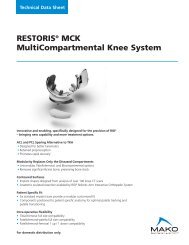Accuracy of Robotic UKA - ISTA presentation - MAKO Surgical Corp.
Accuracy of Robotic UKA - ISTA presentation - MAKO Surgical Corp.
Accuracy of Robotic UKA - ISTA presentation - MAKO Surgical Corp.
Create successful ePaper yourself
Turn your PDF publications into a flip-book with our unique Google optimized e-Paper software.
<strong>Accuracy</strong> <strong>of</strong> <strong>Robotic</strong> Arm<br />
Assisted <strong>UKA</strong><br />
Martin Roche, MD<br />
Dimitri Augustin, MS<br />
Michael Conditt, PhD<br />
Holy Cross Hospital, Ft Lauderdale, FL, USA<br />
21st Annual Congress <strong>of</strong> <strong>ISTA</strong>, Seoul, Korea<br />
October 3, 2008<br />
201847 r00
Why <strong>UKA</strong><br />
• Faster recovery and return<br />
to function<br />
• Smaller incisions<br />
• Less bone resection<br />
• Limited pain<br />
• Less blood loss<br />
• More normal<br />
kinematics/function<br />
POD #1
Why not Conventional <strong>UKA</strong><br />
• More technically demanding then TKA<br />
• Longer learning curve than TKA<br />
• Less forgiving<br />
– Poorly implanted <strong>UKA</strong>s will fail early<br />
• Difficult to consistently restore tibial slope<br />
and coronal alignment
<strong>MAKO</strong>plasty<br />
• Surgeon Interactive <strong>Robotic</strong> Arm<br />
• Computer Assisted Planning and Guidance<br />
– Implant Positioning and Sizing<br />
– Balance & Alignment<br />
• Intelligent Bone Cutting/Shaping Tool<br />
– Elimination <strong>of</strong> instrumentation & IM intervention<br />
• MIS compatible<br />
Reproducible and Consistent Results!!!
Clinical Study<br />
• First 43 <strong>MAKO</strong>plasty procedures (June 2006)<br />
• 42 patients (23 female, 19 male)<br />
• Avg age: 73±11yrs (range: 49 to 97yrs)<br />
• Avg height 67±3in<br />
• Avg weight 185±37lbs<br />
• Avg BMI <strong>of</strong> 29±5<br />
• 38% obese
Femoral Component<br />
Minimum<br />
Ideal<br />
Maximum<br />
A - Flexion/Extension<br />
4° flexion<br />
10° flexion<br />
15° flexion<br />
B - Proximodistal Position<br />
1mm distal <strong>of</strong> bone<br />
2mm distal <strong>of</strong> bone<br />
3mm distal <strong>of</strong> bone<br />
E - Varus/Valgus<br />
0° valgus<br />
5° valgus<br />
10° valgus<br />
F - Mediolataral Position<br />
no med overhang<br />
ideal coverage<br />
No lat overhang<br />
Tibial Component<br />
Minimum<br />
Ideal<br />
Maximum<br />
C – Posterior Slope<br />
0° posterior<br />
4° posterior<br />
7° posterior<br />
D - Proximodistal Position<br />
3mm prox <strong>of</strong> bone<br />
2mm prox <strong>of</strong> bone<br />
4mm distal <strong>of</strong> bone<br />
G - Varus/Valgus<br />
10° varus<br />
3° varus<br />
Neutral<br />
H - Mediolataral Position<br />
2mm min fr. cortex<br />
2mm min fr. cortex<br />
2mm from eminence
Pre-Op Plan and Post-Op Placement
Pre-Op Plan and Post-Op Placement<br />
avg error<br />
RMS error<br />
std dev<br />
tibial component<br />
varus<br />
0.6°<br />
less varus<br />
1.9°<br />
1.9°<br />
posterior tibial<br />
slope<br />
0.1°<br />
less slope<br />
1.7°<br />
1.8°
Outliers<br />
4/344 were outliers (1%)<br />
100%<br />
Femoral Component<br />
Tibial Component<br />
80%<br />
% not outliers<br />
60%<br />
40%<br />
20%<br />
0%<br />
93% 100% 100% 100% 98% 100% 100% 100%<br />
ML Position Varus/Valgus PD Position Flexion/Slope<br />
Measurement (deg/mm)
• femoral component<br />
– medial position
• femoral component<br />
– too proud
• femoral component<br />
– too large<br />
– tight flexion gap
• femoral component<br />
– medial overhang
Conclusions<br />
• <strong>Robotic</strong> arm assisted <strong>UKA</strong> is accurate and<br />
precise with very few outliers.<br />
• Impressive because this is inaugural<br />
series.<br />
• This technology has great potential to<br />
improve accuracy and enhance safety with<br />
procedures that are less forgiving and<br />
more technically difficult.
Thank You!!<br />
201847 r00
















